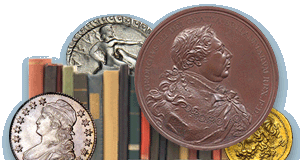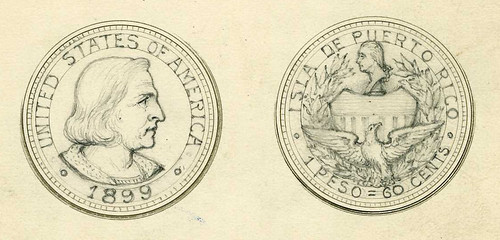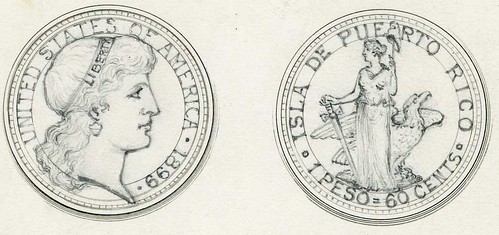
PREV ARTICLE
NEXT ARTICLE
FULL ISSUE
PREV FULL ISSUE
NEW ARTICLE: PUERTO RICO'S PROVINCIAL PESOSResearcher Ángel Navarro published the results of his long-running research on Puerto Rico's Provincial Pesos and Dollars in the 2024 edition of the Numismatic Chronicle published by The Royal Numismatic Society of London. Here's a short excerpt. -Editor Models for Morgan's proposed Puerto Rican coinage: the 1882 Liberty portrait (left) and the 1890/1 Columbia and Eagle pattern (right). Images courtesy of Heritage Auctions, www.HA.com. Abstract: This article aims to reconstruct a segment of Puerto Rico's monetary history from the late nineteenth and early twentieth century, focusing on the transition from the Puerto Rican provincial currency (the ‘peso') to the United States dollar after the Spanish American War. Following the conclusion of the conflict, the Puerto Rican currency saw a swift devaluation, leading to its subsequent withdrawal from circulation. This study, which draws on newly discovered archival sources, suggests that US authorities contemplated the creation of a separate coinage for Puerto Rico, which aimed to ease the conversion from the provincial peso to the US dollar. Introduction Coins have long been considered as one of a nation's prime sovereign symbols, and for this reason the monetary and economic history of Puerto Rico presents significant difficulties. The island did not establish an official currency until the end of the nineteenth century, and before this time a variety of coins circulated concurrently, each with a unique origin, distinct intrinsic value, questionable legal standing, and local value distinct from its international value. This reliance on foreign currency, combined with protracted currency shortages and constant modifications to the monetary system, created conditions that were more than sufficient to impede the local circulation of goods and the formation of capital. By the 1890s the Spanish authorities had started to contemplate a definite solution to this dilemma. The provincial peso of Puerto Rico (1895–6) On 17 August 1895 Queen Regent María Cristina granted the Puerto Rican people the right to use their own currency. The new coin was known as the Puerto Rican provincial peso, and was manufactured under the direction of Don Tomás Castellano y Villarroya, the Minister of Overseas. The Spanish authorities likewise created a currency for the Philippines in return for this same concession. However, due to the outbreak of the War of Independence in 1895, Spain's other remaining Caribbean territory, Cuba, was not granted its own provincial money. That same year, Antonio Cánovas del Castillo's conservative Spanish cabinet, which included the Minister of Overseas Don Tomás Castellano y Villarroya, sought to address Puerto Rico's financial difficulty. In order to tackle the island's economic problem, he deliberated on three proposals:
While the gold standard project was considered ideal, it was not considered viable at that time for two main reasons. Firstly, it was thought to be unreasonably costly for Spain to place its colony on a gold standard when it could not afford to do so. Secondly, if the gold standard was introduced to Puerto Rico, it was suspected that the gold coins that were in circulation would immediately disappear, depriving the island of its currency. Many people were sceptical of the plan to make Puerto Rico's currency identical to Spain's. The fundamental issue was that, if Mexican pesos were to replace Spanish currency, the balance of payments would mean that Spanish funds would leave Puerto Rico and be sent back to Spain and, by extension, to other countries via Spain. There would have been a catastrophic scarcity of currency in circulation if this had happened in Puerto Rico. The third option was chosen, leading to the creation of a unique currency for Puerto Rico known as the Provincial Currency. -Editor Ángel adds: "I began the research with Dr. Richard Doty almost two decades ago, and just recently I finally expanded it thanks to Mr. Roger W. Burdette, Len Augsburger and a grant from the Eric P. Newman Numismatic Education Society." Roger adds: "The 1891-dated pattern was also used on the 1906 experimental double eagle to test edge lettering for the Saint-Gaudens double eagle patterns." The article also illustrates design sketches for the proposed Puerto Rican coinage. Images courtesy of the National Numismatics Collection, National Museum of American History, Smithsonian Institution. -Editor
Wayne Homren, Editor The Numismatic Bibliomania Society is a non-profit organization promoting numismatic literature. See our web site at coinbooks.org. To submit items for publication in The E-Sylum, write to the Editor at this address: whomren@gmail.com To subscribe go to: Subscribe All Rights Reserved. NBS Home Page Contact the NBS webmaster 
|



